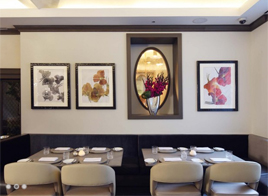Charlie Bird
 Monday, October 28, 2013 at 08:23PM
Monday, October 28, 2013 at 08:23PM 
 Once burned, twice careful? How else do you explain the very good, and yet timid, restaurant that is Charlie Bird?
Once burned, twice careful? How else do you explain the very good, and yet timid, restaurant that is Charlie Bird?
Let’s rewind a bit. Robert Bohr was a partner and sommelier at Cru, one of the city’s best restaurants of the mid-2000s. Frank Bruni awarded three stars right off the bat. Rumor had it Bruni was considering a fourth. I gave it three and a half stars.
 In an era when most restaurants were becoming more casual, Cru actually got fancier in its first four years, 2004–08. By the peak, it had a 150,000-bottle wine cellar, with a list so hefty they presented it in two volumes, each the size of a phone directory.
In an era when most restaurants were becoming more casual, Cru actually got fancier in its first four years, 2004–08. By the peak, it had a 150,000-bottle wine cellar, with a list so hefty they presented it in two volumes, each the size of a phone directory.
Then the The Great Recession hit. Hedge fund moguls were no longer dropping in and buying the three- and four-figure trophy wines that the business model depended on. The chef left; his replacement was told to dumb down the menu.
I predicted that plan would fail, and it did. As I asked at the time, when the core of your wine list is bottles in the hundreds and thousands, what does it matter if entrée prices are slashed $5 or $10 apiece? Cru closed in 2010.
 Bohr moved onto other ventures for a while before opening Charlie Bird in June. The restaurant is, of course, wine-centric: how could it not be? But neither the food nor the wine attempts anything like the ambition of Cru at any point in its six-year run.
Bohr moved onto other ventures for a while before opening Charlie Bird in June. The restaurant is, of course, wine-centric: how could it not be? But neither the food nor the wine attempts anything like the ambition of Cru at any point in its six-year run.
I can understand not trying to reproduce Cru, but with the economy now on an upswing, and restaurants like Costata and Carbone pulling in the high rollers again, I think Bohr could have aimed higher than he did.
Mind you, Charlie Bird is very good for what it is, but the food itself is not destination material. It’s good “neighborhood-plus” Italianesque food, which you can get all over town. The wine list, which The Times’s Eric Asimov recently named one of the city’s twelve best, is what makes Charlie Bird a destination.






















